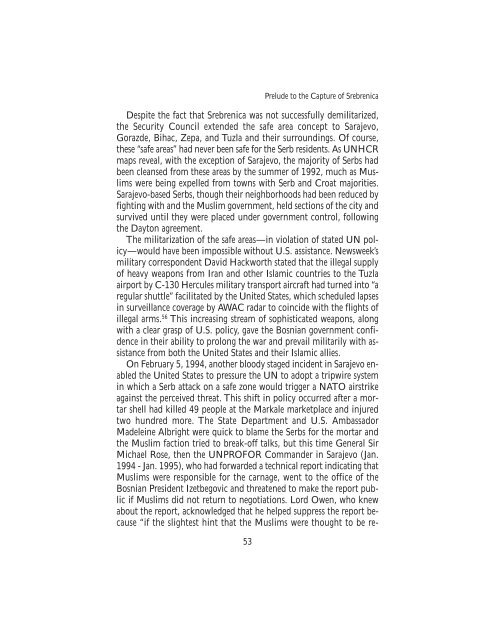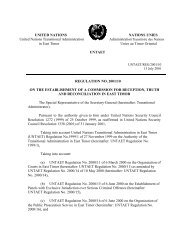The Srebrenica Massacre - Nova Srpska Politicka Misao
The Srebrenica Massacre - Nova Srpska Politicka Misao
The Srebrenica Massacre - Nova Srpska Politicka Misao
Create successful ePaper yourself
Turn your PDF publications into a flip-book with our unique Google optimized e-Paper software.
Prelude to the Capture of <strong>Srebrenica</strong><br />
Despite the fact that <strong>Srebrenica</strong> was not successfully demilitarized,<br />
the Security Council extended the safe area concept to Sarajevo,<br />
Gorazde, Bihac, Zepa, and Tuzla and their surroundings. Of course,<br />
these “safe areas” had never been safe for the Serb residents. As UNHCR<br />
maps reveal, with the exception of Sarajevo, the majority of Serbs had<br />
been cleansed from these areas by the summer of 1992, much as Muslims<br />
were being expelled from towns with Serb and Croat majorities.<br />
Sarajevo-based Serbs, though their neighborhoods had been reduced by<br />
fighting with and the Muslim government, held sections of the city and<br />
survived until they were placed under government control, following<br />
the Dayton agreement.<br />
<strong>The</strong> militarization of the safe areas—in violation of stated UN policy—would<br />
have been impossible without U.S. assistance. Newsweek’s<br />
military correspondent David Hackworth stated that the illegal supply<br />
of heavy weapons from Iran and other Islamic countries to the Tuzla<br />
airport by C-130 Hercules military transport aircraft had turned into “a<br />
regular shuttle” facilitated by the United States, which scheduled lapses<br />
in surveillance coverage by AWAC radar to coincide with the flights of<br />
illegal arms. 56 This increasing stream of sophisticated weapons, along<br />
with a clear grasp of U.S. policy, gave the Bosnian government confidence<br />
in their ability to prolong the war and prevail militarily with assistance<br />
from both the United States and their Islamic allies.<br />
On February 5, 1994, another bloody staged incident in Sarajevo enabled<br />
the United States to pressure the UN to adopt a tripwire system<br />
in which a Serb attack on a safe zone would trigger a NATO airstrike<br />
against the perceived threat. This shift in policy occurred after a mortar<br />
shell had killed 49 people at the Markale marketplace and injured<br />
two hundred more. <strong>The</strong> State Department and U.S. Ambassador<br />
Madeleine Albright were quick to blame the Serbs for the mortar and<br />
the Muslim faction tried to break-off talks, but this time General Sir<br />
Michael Rose, then the UNPROFOR Commander in Sarajevo (Jan.<br />
1994 - Jan. 1995), who had forwarded a technical report indicating that<br />
Muslims were responsible for the carnage, went to the office of the<br />
Bosnian President Izetbegovic and threatened to make the report public<br />
if Muslims did not return to negotiations. Lord Owen, who knew<br />
about the report, acknowledged that he helped suppress the report because<br />
“if the slightest hint that the Muslims were thought to be re-<br />
53



